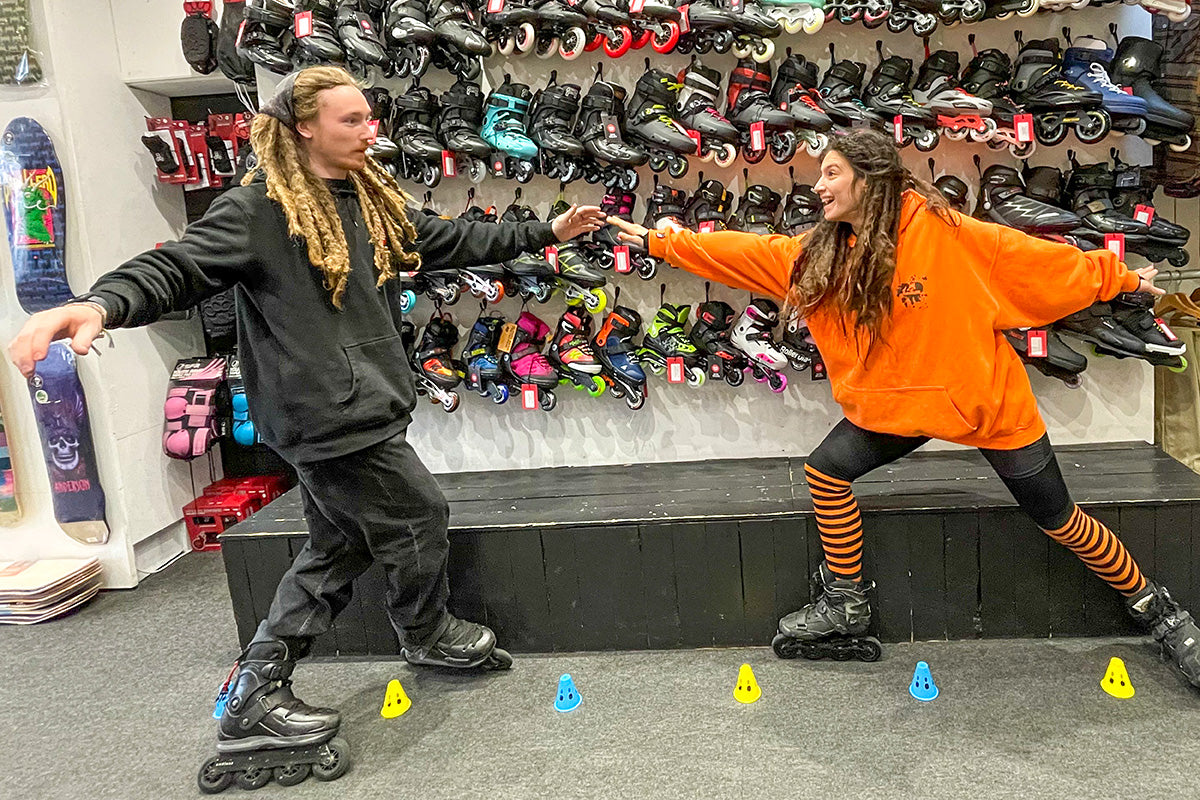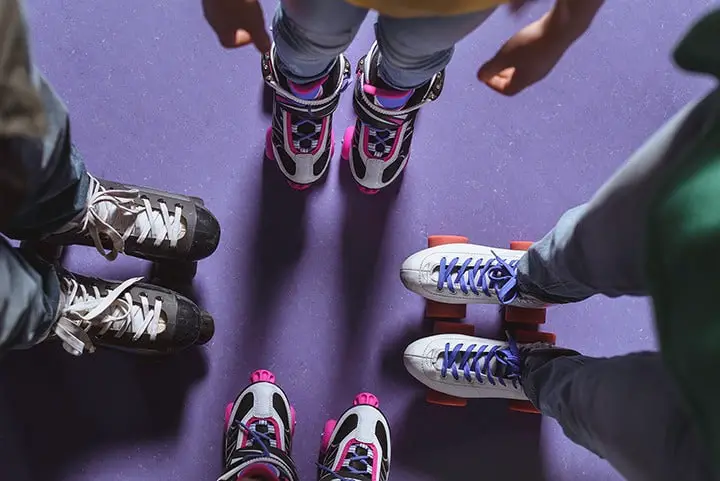How to Prevent Injuries While Inline Skating? : Master the Art of Safe Skating!
( If you purchase through our sponsored links, we may receive a small commission at no extra cost to you )
To prevent injuries while inline skating, wear protective gear and practice proper technique. Now let’s explore some tips to ensure your safety while enjoying this exhilarating activity.
Inline skating is a fun and thrilling way to get outdoors and stay active. However, it’s important to take precautions to prevent injuries. Wearing protective gear, such as a helmet, wrist guards, knee pads, and elbow pads, is essential to protect vulnerable areas of your body.
Additionally, practicing proper technique, such as maintaining a balanced and stable posture, using controlled movements, and gradually increasing speed and difficulty, can help reduce the risk of injury. By following these tips and staying alert to your surroundings, you can have a safe and enjoyable inline skating experience.

Credit: www.slickwillies.co.uk
Understanding Inline Skating Injuries
Inline skating is a thrilling and popular activity that allows individuals to enjoy the outdoors while getting in a great workout. However, like any sport or physical activity, there is always a risk of injuries. Understanding the types of injuries that can occur while inline skating and their causes is crucial for preventing them and ensuring a safe and enjoyable experience.
Types Of Common Inline Skating Injuries
Inline skating injuries can vary in severity, from minor bruises and scrapes to more serious fractures and sprains. Here are some of the most common types of injuries that inline skaters may encounter:
| Type of Injury | Description |
|---|---|
| Bruises | Superficial skin injuries caused by falls or collisions. |
| Fractures | Broken bones resulting from high-impact falls or accidents. |
| Sprains | Stretching or tearing of ligaments due to twisting or rolling of the ankle. |
| Abrasions | Deep cuts or scrapes that may require medical attention. |
| Concussions | Head injuries caused by falls or collisions, requiring immediate medical evaluation. |
Causes Of Inline Skating Injuries
Understanding the causes of inline skating injuries is essential for preventing them. Here are some of the common factors that contribute to inline skating injuries:
- Lack of protective gear: Failing to wear essential safety equipment like helmets, knee pads, elbow pads, and wrist guards increases the risk of injury.
- Inadequate training and skill level: Inexperienced skaters who attempt advanced maneuvers or skate on challenging terrain without proper skills are more likely to get injured.
- Unsafe skating environments: Skating on uneven or poorly maintained surfaces, crowded areas, or areas with obstacles increases the chances of accidents and injuries.
- Speed and loss of control: Skating at excessive speeds or losing control while maneuvering can lead to falls and collisions, resulting in injuries.
- Failure to follow traffic rules: Inline skaters must adhere to traffic rules, yielding to pedestrians and following regulations, to avoid accidents and injuries.
By being aware of these common types and causes of inline skating injuries, you can take proactive measures to prevent them. Practice proper safety precautions, upgrade your skating skills gradually, and always be mindful of your surroundings. Stay safe and enjoy the exhilarating experience of inline skating!

Credit: www.nytimes.com
Essential Safety Gear For Inline Skating
To prevent injuries while inline skating, it is essential to wear safety gear such as a helmet, knee pads, elbow pads, and wrist guards. These protective equipment will provide cushioning and support, reducing the risk of injuries in case of falls or accidents while enjoying the adrenaline rush of inline skating.
Inline skating is an exhilarating sport that offers a fantastic way to stay active and enjoy the outdoors. However, it’s important to prioritize safety while participating in this activity. Wearing the appropriate safety gear can significantly reduce the risk of injuries during inline skating. In this section, we will discuss the essential safety gear you should consider using to protect yourself. Remember, safety should always be your top priority!
Helmets
A helmet is an absolute must-have when it comes to inline skating. It provides crucial protection for your head, safeguarding you from potential head injuries in case of falls or collisions. The helmet you choose should be specifically designed for inline skating or rollerblading, ensuring maximum impact resistance. Look for helmets that meet safety certifications, such as ASTM F1492 or CPSC. It’s important for the helmet to fit snugly and cover the entirety of your forehead. Remember, a properly fitted helmet can save your life.
Protective Pads
Protective pads are another essential component of inline skating safety gear. They offer added protection to vulnerable areas of your body, such as your elbows, knees, and wrists. These pads are typically made from durable materials like hard plastic or foam and are designed to absorb impacts. When shopping for protective pads, make sure they fit well and do not restrict your range of motion. Look for pads with adjustable straps to ensure a secure fit. By investing in protective pads, you can reduce the risk of fractures, scrapes, and painful bruises.
Appropriate Footwear
Having the right footwear is crucial for inline skating. Your skates should fit comfortably and provide proper ankle support. Look for skates that have a snug fit without being too tight or too loose. The skates should offer good ankle support to prevent sprains and strains. Additionally, ensure that the wheels and bearings of your skates are in good condition and suitable for the type of terrain you’ll be skating on. Worn-out wheels or faulty bearings can lead to accidents and injuries. Remember, wearing appropriate footwear is vital for stability and control.
Reflective Clothing
Visibility is key when skating outdoors, especially if you prefer skating during the evening or at night. Wearing reflective clothing is essential to make yourself more visible to motorists and other pedestrians. Invest in clothing with reflective strips or opt for clothing that has built-in reflective materials. This will ensure that you can be seen by others, reducing the risk of accidents. Even during the day, wearing bright and vibrant colors can enhance your visibility on the road. Remember, being seen is being safe.
By prioritizing safety and investing in the essential gear mentioned above, you can prevent injuries and enjoy inline skating with peace of mind. Remember, accidents can happen to anyone, regardless of their experience level. Don’t compromise on safety and make sure to wear your helmet, protective pads, appropriate footwear, and reflective clothing every time you hit the skating rink or the streets. Stay safe and have fun!
Practicing Safe Inline Skating Techniques
Inline skating is a thrilling and exhilarating activity that allows you to glide through the streets with speed and grace. However, like any other physical activity, it comes with its fair share of risks. To ensure a safe and enjoyable experience, it’s crucial to practice proper inline skating techniques. By maintaining proper posture and balance, mastering basic skating maneuvers, avoiding high-risk areas, understanding the rules of the road, and skating with caution in various weather conditions, you can greatly reduce the chances of sustaining injuries while inline skating.
Maintaining Proper Posture And Balance
One of the most important aspects of inline skating is maintaining proper posture and balance. This not only ensures optimal performance but also helps prevent injuries. To maintain good posture, stand up straight with your knees slightly bent and feet shoulder-width apart. Lean slightly forward and keep your head up, focusing on the path ahead. Maintaining a strong core and engaging your abdominal muscles will provide stability and help you maintain balance as you glide along.
Mastering Basic Inline Skating Maneuvers
Before venturing out onto busy streets or crowded parks, it’s essential to master basic inline skating maneuvers. Start by practicing the basic stride, pushing one foot forward while the other foot pushes backward. This motion should be smooth and controlled, generating enough speed to keep you moving comfortably. Additionally, learn how to execute basic turns and stops, as these skills are essential for navigating through various skating environments. Taking the time to perfect these fundamental maneuvers will boost your confidence and significantly reduce the risk of accidents.
Avoiding High-risk Skating Areas
When it comes to inline skating, choosing the right location is crucial. Avoid high-risk skating areas such as busy streets, uneven pavements, and areas with heavy vehicular traffic. Look for designated skate parks, well-maintained paths, or quiet neighborhood streets that provide a smoother riding surface. These areas offer a safer and more controlled environment for inline skating, minimizing the risk of colliding with obstacles or vehicles. Always prioritize your safety by selecting the appropriate skating areas.
Understanding The Rules Of The Road
Inline skating often takes place alongside pedestrians, cyclists, and other road users. To skate responsibly and minimize the risk of accidents, it’s important to understand and follow the rules of the road. In many countries, inline skaters are considered pedestrians, meaning they should stick to the sidewalks or shared-use paths. However, be mindful of other pedestrians and communicate your intentions by using hand signals when necessary. Keep to the right side of the path, pass with caution, and be aware of your surroundings at all times to ensure a safe and enjoyable skating experience.
Skating With Caution In Various Weather Conditions
Weather conditions can greatly impact your inline skating experience and safety. When skating outdoors, it’s essential to be aware of the weather forecast and adjust your plans accordingly. Avoid skating in extreme weather conditions, such as heavy rain or snow, as these can create slippery surfaces and increase the chances of accidents. Additionally, be cautious when skating in wet or icy conditions, as these surfaces can be treacherous. Ensure your wheels are clean and dry, providing adequate traction for better control. By staying informed and adapting to different weather conditions, you can minimize the risk of injuries while inline skating.

Credit: issuu.com
Frequently Asked Questions For How To Prevent Injuries While Inline Skating?
What Can You Do To Prevent Inline Skating Injuries?
To prevent inline skating injuries, follow these tips: 1. Wear protective gear like helmets, knee pads, and wrist guards. 2. Maintain a safe speed and be aware of your surroundings. 3. Learn proper techniques, such as how to stop and fall safely.
4. Check your equipment regularly for any defects or damage. 5. Practice on smooth surfaces and avoid uneven or crowded areas.
How Do I Make My Inline Skates Not Hurt?
To make your inline skates more comfortable and prevent pain: 1. Wear thick socks for extra cushioning. 2. Adjust the tightness of the skates to fit your feet properly. 3. Use gel pads or insoles to absorb shock and reduce pressure on your feet.
4. Gradually break in your skates by wearing them for short periods at first. 5. Improve your skating technique to minimize strain on your feet.
What Is The Correct Method Of Stopping Safely With Inline Skates?
To stop safely with inline skates, follow these steps: 1. Bend your knees and lean slightly forward. 2. Bring your feet together and angle them slightly inward. 3. Shift your weight to the back foot. 4. Gradually apply pressure to the brake pad on the back skate.
5. Allow the brake to slow you down and come to a stop.
How Do You Not Get Hurt When Roller Skating?
To avoid injury while roller skating, follow these tips: 1. Wear protective gear like helmets, knee pads, and wrist guards. 2. Learn and practice proper skating techniques. 3. Choose smooth and even surfaces for skating. 4. Stay alert and aware of your surroundings at all times.
5. Start with slow speeds and gradually increase as you gain confidence
Conclusion
Preventing injuries while inline skating is crucial for enjoying this sport safely. By following the proper safety precautions such as wearing protective gear, staying alert and focused, maintaining the equipment, and practicing good technique, skaters can significantly reduce the risk of injuries.
Remember, safety should always be the top priority to ensure a fun and injury-free skating experience.
Read Also: Benefits of Inline Skating





